Last updated on December 31st, 2023 at 08:08 pm
Most amp simulators are usually acclaimed for their heavier tones and no one really seems to talk that much about how realistic their clean tones actually sound.
I decided to write this post to give you a better idea of how certain guitar VSTs handle the clean side of things.
Note: I tried all of the amp simulators on this list and I even own a copy of most of them, and funny enough, I like the most affordable ones the best.

BIAS Amp II
BIAS AMP II offers the absolute best in-depth amp design and tweaking capabilities.

BIAS FX II
Best Amp Simulation software suite in terms of cost-efficiency. Sounds incredibly realistic.
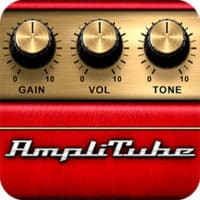
Amplitube 5
Big Amp suite with multiple amps, cabinets, and effects. Easy to get a good & realistic sound.
Let’s get straight into the list!
Best Amp Sims for Jazz
Here I will be listing the Amp Sims I found that can give you the absolute best clean and jazzy tones.
Note: All of these are paid and will range from $60 to $300. So, if you’re more interested in freeware amp sims, then scroll down to the section where I list those.
On that same note, I wrote a complete list of the best Guitar VSTs and Amp Simulation plugins that you should definitely check out as well!
BIAS Amp II ($54 – $164)
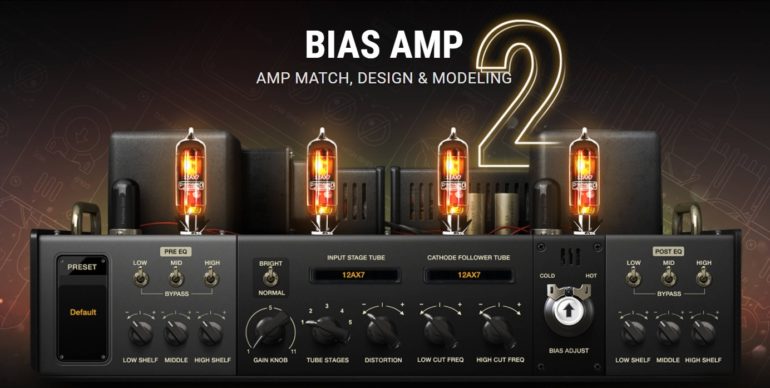
I’ve played through many amp simulators over the years and I have to say that BIAS AMP II is definitely my favorite as far as clean tones go.
It sounds extremely realistic and you can get your hands on the standard package for only $54, which is much more affordable than most other amp sims out there.
What sets BIAS Amp II apart from all the other amp simulation plugins I’ve tried over the years, is the huge customization options available that will let you shape the tone in any way you like.
This, however, is both a pro and a con for the simple fact that having 100+ components that you can switch and adjust, or combine in any way you like, can let you achieve a very unique tone, but at the same time, you can get too caught up in the details and spend hours trying to perfect the sound.
I personally select a preset and then adjust from there. But the presets themselves already sound extremely good, so there’s not too much time that goes into customizing the sound.
As a side note; you can get crunchy- and even extremely heavy tones out of BIAS Amp II, and while they do sound great, I mainly use it for its clean tones.
This is my number one choice for anyone who wants to achieve a jazzy tone since you can really dive into the settings and recreate the sound of any famous jazz amplifier.
Important Note: BIAS Amp doesn’t come with any effects/stompboxes, etc. It’s just software designed to let you customize the amps to your liking.
This means that on its own, it’s a bit limited.
The good news is that you can use it with BIAS FX II, which will let you add FX and more.
Lastly, BIAS Amp II can work as a standalone unit, meaning that you don’t need to open it up in your DAW if you simply want to jam along to some songs or if you want to customize the sounds and save them as presets.
Get BIAS Amp II Here: Pluginboutique, Reverb, Sweetwater.
BIAS FX II ($54 – $164)

BIAS FX II is a bit different from BIAS Amp in the sense that it’s not so heavily focused on amp configuration, but it rather gives you a bit of everything; From different amps and cabinets to stompboxes, microphones, etc.
As far as the clean tones go, they do sound great, but you will be very limited in regards to how much you get to tweak the sound of the amp itself.
However, both programs can actually work together, meaning that you can configure an amp in BIAS amp exactly how you want it and then use BIAS FX to add effects to it.
The feature that sets BIAS FX II apart from most other amp sim plugins out there, is that you can split the signal into two different amplifiers, add effects to each of them and blend them back together.
This gives you a lot of customization options.
With BIAS FX II you will be able to control the mic placement, as well as choose from a couple of different microphones, and you can also select hundreds of different speakers to be used in the cabinets.
Their latest addition are the Celestion speakers, and these sound fantastic!
Now, BIAS FX II does use quite a lot of CPU power, way more than BIAS Amp or Amplitube, and the interface feels a bit slow and clunky, which is also another reason I use AMP II a lot more.
I would recommend BIAS FX II over BIAS Amp II to anyone who is looking for simplicity, since the amp customization is much more limited, and to anyone who needs to add effects.
Get BIAS FX II here: Pluginboutique, Reverb, Sweetwater.
Note: Both the demo versions of BIAS AMP II and FX II can be downloaded for free and used for free for an unlimited amount of time.
However, every 3 or 4 minutes you will hear a high-pitched sound on BIAS FX, and the sound will be cut off for 5 sec or so in BIAS Amp.
Amplitube 5 ($149.99)

Even though Amplitube 5 might be a bit more on the pricier side than other amp sims, I’ve always thought that it excels at creating great-sounding clean tones.
It might not be AS realistic as BIAS Amp II, at least not to my ears, but it certainly sounds great.
Now, Amplitube 5 has one advantage over BIAS Amp II which is that it comes with all the effects already built-in, meaning that despite not letting you customize the amp sound as much, you can definitely add other effects directly on the software itself.
When you purchase Amplitube 5 you get a total of 10 Stompboxes, 9 Amps, 10 Cabinets, 29 speaker models, 4 microphones, 2 rack effects units, and 2 tuners.
If this isn’t enough, which I believe it should be, especially if you’re only after clean jazzy tones, you can purchase more individual components in their custom shop.
Also, if you’re looking for some awesome clean tones, then check the official Fender Amp collection that Amplitube has to offer.
The feature that sets Amplitube 5 apart from all the other amp sims is the “Cab Room”.
The Cab Room lets you customize every aspect of how the cabinet sounds; from 3D mic placement and choosing the microphone types, to being able to choose each individual speaker inside of the cabinet, as well as selecting the room the cabinet is recorded in, and much more.
From the tests I’ve done, achieving good-sounding clean jazzy tones is definitely achievable (I was even able to get some pretty convincing jazz tones out of my strat by rolling off the tone knob slightly).
Now, I know that spending $150 on an amp sim can be quite a lot, but luckily, you can try the software out for free for 15 days, and this will give you full access to all the premium features until the trial period expires.
Get Amplitube 5 here: Sweetwater.
Guitar Rig Pro 6 by Native Instruments ($199)

Guitar Rig is a complete drag-and-drop amp simulation suite that comes which loads of stompboxes, effects, amp, cabinets, and more.
If there’s one thing Guitar Rig excels at, it is the ease of use; just select the amp, cabinet, or effect that you like, drag it into the chain and that’s it, you’re ready to start making music.
Since it’s got so many different features, you can seriously tweak the tones to your liking;
If you need a heavy rock tone, a super clean and clear sounding tone, a crunchy tone, or even drown your guitar sound in chorus and reverb effects, Guitar Rig has got you covered.
What are its Strengths; Guitar Rig Pro 5 is a great all-rounder.
Get Guitar Rig Pro 6 here: Native Instruments.
Overloud TH-U ($299)
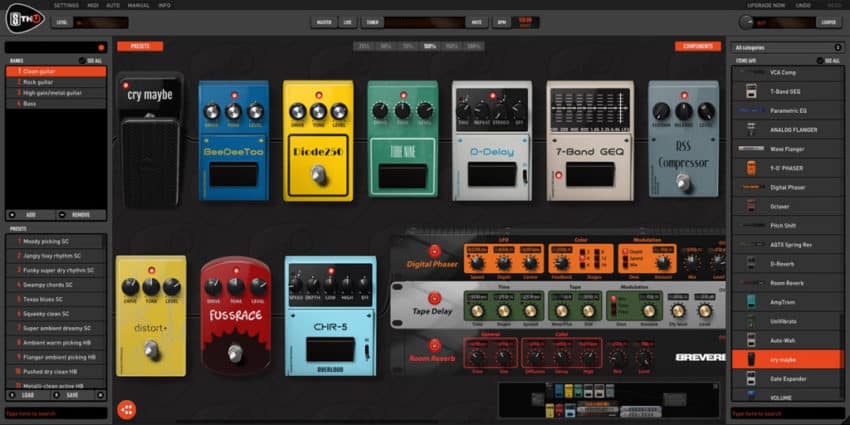
Last but not least we have Overloud TH-U, which is a huge amp simulation software that comes with 89 guitar amps, 50 guitar cabinets, 77 stompboxes and effects, and more.
It even comes with a couple bass amps and cabinets.
Now, while it may have the most features of any of the amp sims on this list, it’s also the most expensive.
Note: BIAS FX and Amplitube 4 have the same number of features, if not more, but you can purchase more affordable versions of their software and upgrade later on. With TH-U you will have to buy everything at once, making it less appealing to someone who isn’t certain about which software to get.
Now, the sound quality is absolutely amazing, as you would expect; You can achieve any type of clean tone you want, especially with the huge array of amps and cabinets at your disposal.
Luckily, Overloud decided to give us access to the full software with absolutely no limitations for 15 days by simply giving them your email address.
Get TH-U Full here: Sweetwater.
On a side note, I wouldn’t really recommend TH-U to anyone who is only looking to get some good-sounding clean tones… It’s a bit overkill in my opinion.
Free Amp Sims for Jazz
Who doesn’t like free stuff? Well, here are the best free amp simulation plugins that can achieve great clean/jazzy tones.
Ace by Shattered Glass Audio

This one is an oldie, and it’s an emulation of a 1950s, American, all tube, 5W, tweed amp.
But despite being old, it still is one of my favorites as far as free guitar VSTs go.
As far as customization goes, there isn’t really that much that this plugin has to offer, but it sounds quite good straight out of the box.
The only controls you will have access to are; Input, Volume, Output and Feedback.
Lastly, the plugin also features a built-in cabinet simulation and two different circuit models (one of which emulates additional grid stopper resistors).
Most other free guitar amp sims out there are designed to achieve heavier tones, but Ace was designed to give guitar players on a budget access to great-sounding clean tones.
The only issue I ran into with Ace was the low end; It sounded boomy and not very defined, but other than that it’s a great plugin.
You can download it here.
Guitar Rig 6 Player
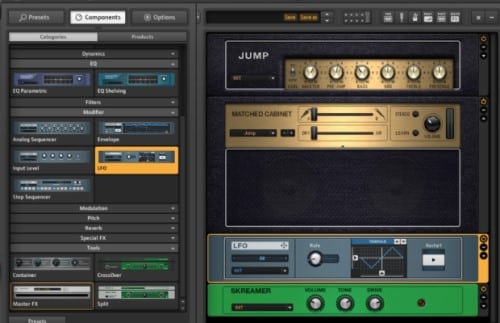
Guitar Rig has always been known to be one of the most expensive alternatives out there, as far as amp simulation goes.
However, they came out with the Player edition, which is essentially a stripped-down version of Guitar Rig 5 Pro that is completely free to download and use.
Now, I’ve never been to big a fan of Guitar Rig as far as clean tones go, especially jazzy ones, but since there aren’t too many other completely free and good-sounding alternatives out there, I’m including it in the list.
The free version only comes with one Amp and one Cabinet, plus a couple effects, but the amp isn’t that well suited for jazzy tones since it sounds a bit “glassy” in my opinion.
Still, you can get pretty amazing results with it if you take your time and dive into the settings; however, it’s not like BIAS Amp II where you select a preset and it already sounds amazing.
While it may not be my top recommendation, I’d still recommend that you get it since it’s free.
You can download it here.
Emissary by Ignite Amps
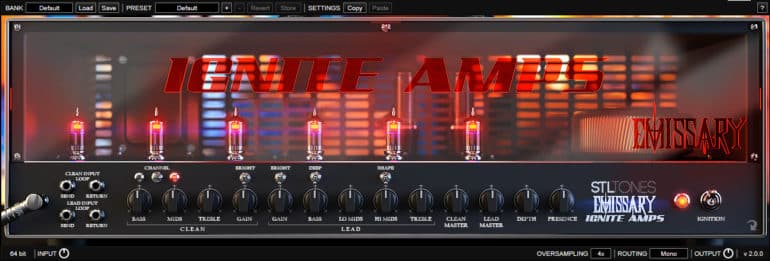
If you know anything about Ignite Amps, then you will probably wonder why I put the Emissary on this list, since they are mostly known for their heavy metal amp sims and the Emissary is definitely a part of those.
However, this amp also has a clean channel that sounds phenomenal!
Now, and this part is very important, you only get the amp when you download the Emissary, and it doesn’t come with a built-in impulse responder/cabinet sim.
The good news is that they also came up with the NadIR, which is probably one of the best impulse responders out there that lets you choose different microphones and do all kinds of things you want to the signal.
It may not look like a clean guitar amp sim, but you can get some pretty nice clean tones out of it, even for jazz, and if you ever want to play rock or metal, then the lead channel will blow your mind, especially considering it’s free.
You can download it here.
My Personal Recommendation
In all honesty, I wouldn’t want to spend close to $300 on an amp sim, especially if I’m only after clean tones and all the high-gain amps and effects won’t really be useful to me.
This is why I’d highly recommend BIAS Amp II or BIAS FX II, especially since you can use them together, since they only sell for $54 each.
Amplitube 4 is great also, but it’s got a slightly higher price tag than those two combined.
Now, people usually turn their nose up at freeware plugins, but I honestly believe that Ace and the Emissary can certainly be used to record awesome clean sounds.
Conclusion
There is absolutely no need to spend a fortune on amp simulators, or any other kind of music production software for that matter.
Free and affordable software are usually capable of doing the same things.
Like I mentioned earlier, I’d personally choose BIAS Amp II or BIAS FX II, and as far as free amp sims go I’d have to choose Ace and the Emissary.
Haver a wonderful day!
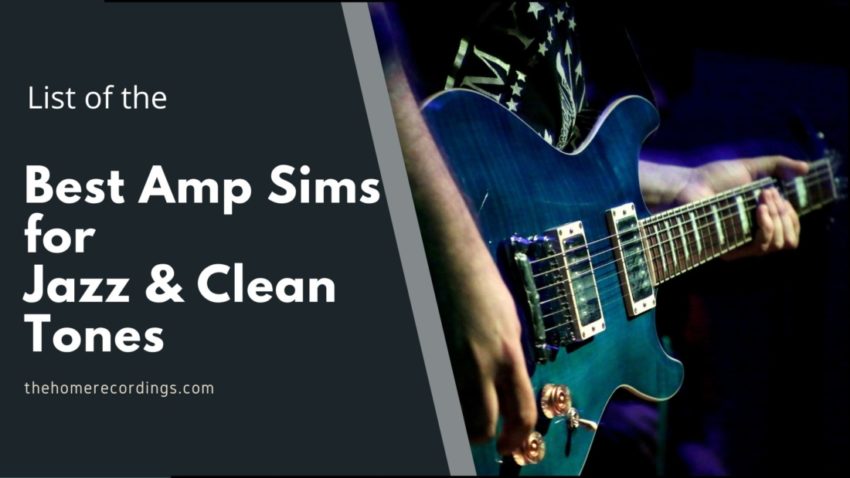
Didn’t get to try Neural DSP’s Plini or Corey Wong Archetype?